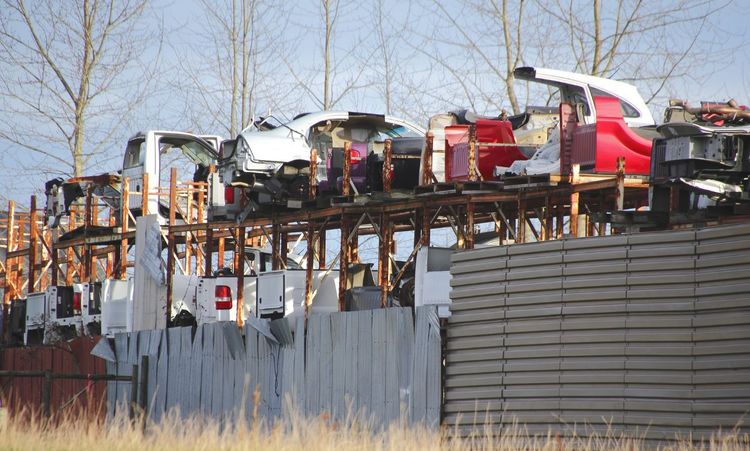Your car faces countless threats on the road every day. From minor parking lot mishaps to severe collisions, auto body damage happens more often than you think. Understanding typical auto body damage can save you time and money. This guide will walk you through the seven most frequent types of auto body damage. You'll learn about repair options and prevention strategies for each type. Let's dive into these common issues that many vehicle owners face regularly.
Dents and Dings

Dents and dings are the most common types of auto body damage. They happen in parking lots from shopping carts and careless door openings. These damages also occur from hailstorms, road debris, or minor collisions. Small dents might seem merely cosmetic, but they can lead to bigger problems. Paint damage often follows denting, exposing your car's body to potential rust.
Repair Options
When it comes to dent repair, you have several effective options. Paintless Dent Repair works best for minor dents without paint damage. This technique manipulates the metal back into its original shape from behind. Traditional dent repair requires extensive filling, sanding, and repainting. The repair cost depends on the dent's size, location, and severity.
I once had a customer who ignored a small dent for months. The area started rusting, which doubled his repair costs. Always address dents promptly to avoid compounding issues.
Scratches
Scratches can happen anywhere and from almost anything. Keys, branches, gravel, or washing with dirty cloths cause scratches. These marks ruin your car's appearance and can lead to serious damage. Deep scratches penetrate through paint layers and expose the metal underneath.
Types of Scratches
When discussing types of scratches, we need to understand their severity levels. Surface scratches only affect the clear coat and are relatively easy to fix. Intermediate scratches penetrate the paint layer but don't reach the primer. Deep scratches expose the metal and require immediate attention to prevent rust. Each scratch type needs a different repair approach and technique.
Prevention and Repair
Preventing scratches requires maintaining safe distances from objects and other vehicles. Regular waxing provides an additional protective layer against minor scratches. Parking away from high-traffic areas reduces the risk of damage from careless drivers. For repair options, light scratches often respond well to polishing compounds. Deeper scratches require professional help for proper sanding and repainting. Scratch repair kits work for minor issues but won't match professional results.
Cracked or Shattered Bumpers

Modern bumpers consist of plastic or fiberglass rather than metal. These materials absorb impact but crack or shatter under sufficient force. Most bumper damage happens during low-speed collisions or parking mishaps. Cracked bumpers compromise your vehicle's safety systems and appearance.
Repair Process
The bumper repair process depends on the severity of the damage and the bumper material. Minor cracks can be filled and sealed with specialized plastic welding equipment. Technicians sand the area smooth and apply matching paint for a seamless finish. Severely damaged bumpers usually require complete replacement rather than repair. Professional shops carefully realign the new bumper to maintain proper fit and safety features.
Paint Damage
Paint damage occurs from various sources, including UV exposure, acid rain, and bird droppings. Chemical spills, tree sap, and improper washing techniques harm your paint. Fading color, peeling, and bubbling indicate serious paint issues that need attention.
Repair and Prevention
Repairing paint damage starts with determining its cause and extent. Touch-up paint works for small chips and scratches if matched correctly. Larger areas require professional repainting to ensure color matching and proper application. Preventing paint damage means parking in shaded areas whenever possible. Regular washing and waxing protect against environmental contaminants. Paint protection films offer an excellent defense against chips and minor scratches.
Rust and Corrosion
Rust forms when metal components are exposed to oxygen and moisture. It spreads quickly if not addressed promptly and adequately. Road salt accelerates the corrosion process, especially in coastal or northern regions. Once rust takes hold, it damages your vehicle's structure from the inside out.
When discussing rust and corrosion, we must emphasize their progressive nature. Surface rust appears as reddish-brown spots on exposed metal areas. Scale rust occurs when the corrosion has started eating through the metal. Penetrating rust creates holes in body panels and requires immediate professional attention. Regular inspections help catch rust in its early stages.
Bumper Damage
Bumpers absorb impact during collisions to protect your vehicle and passengers. They commonly suffer damage from parking mishaps and rear-end collisions. Modern bumpers contain sensors and safety equipment that require specialized repair techniques.
When discussing bumper damage, we must consider visible and hidden issues. Cracks, dents, and misalignment indicate obvious problems requiring attention. Sensors behind bumpers often sustain damage even in minor impacts. Professional shops use special equipment to diagnose and repair these electronic components. Proper bumper repair maintains your car's appearance and critical safety features.
Paint Chips

Paint chips typically result from road debris striking your vehicle at high speeds. These small damages expose bare metal to the elements, inviting rust formation. They commonly appear on front bumpers, hoods, and side panels near wheels.
Timing matters most for paint chip repair. Fresh chips respond well to adequately applied touch-up paint. Older chips might require sanding and more extensive repair before painting. Prevention includes maintaining safe following distances on highways and gravel roads. High-quality paint protection films shield vulnerable areas from flying debris and small impacts.
Conclusion
Understanding these seven common types of auto body damage helps you protect your investment. Early detection and prompt repair prevent minor issues from becoming major problems. Your vehicle deserves proper care to maintain both its appearance and safety features. Always consult professional auto body shops for significant damage assessment and repair. Regular maintenance and preventive measures extend your car's life and preserve its value. Remember that quality repairs might cost more upfront but save money in the long term.
Also Read: How to Prevent Car Door Dents and Dings




